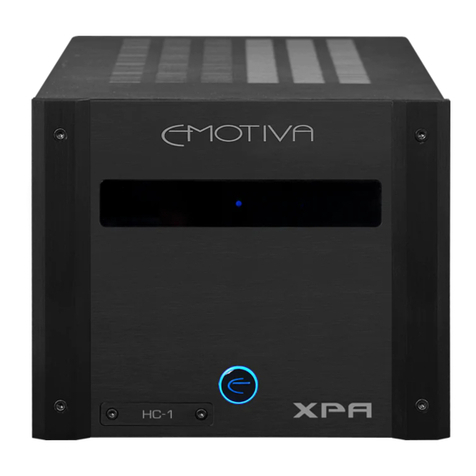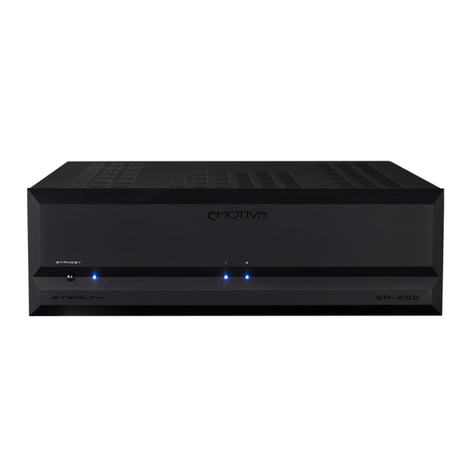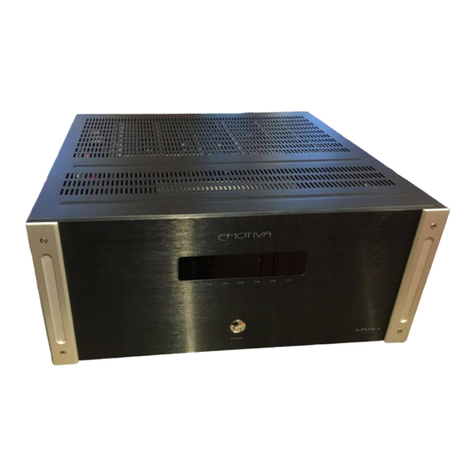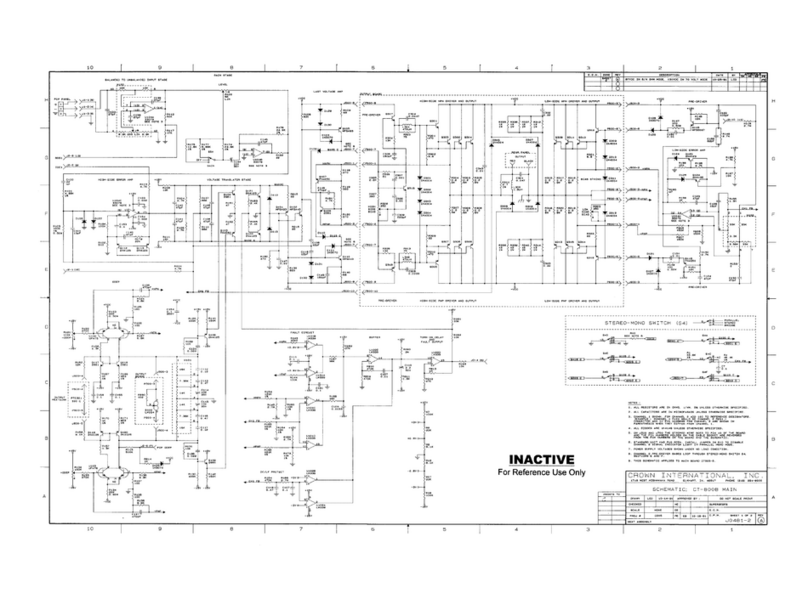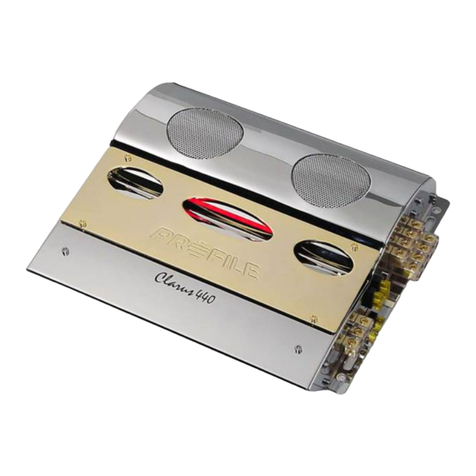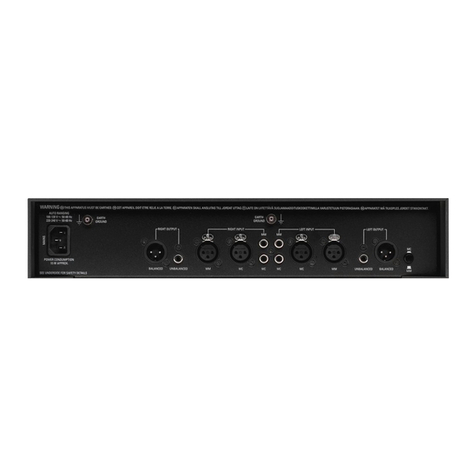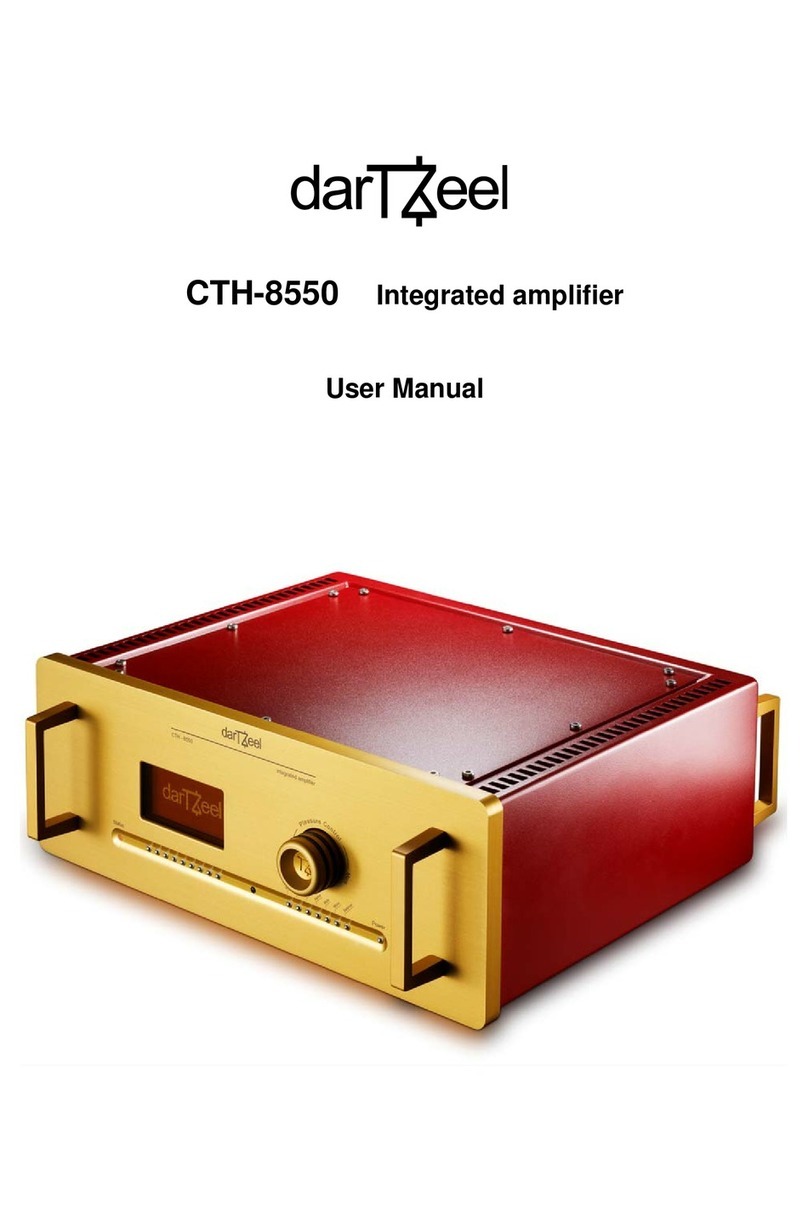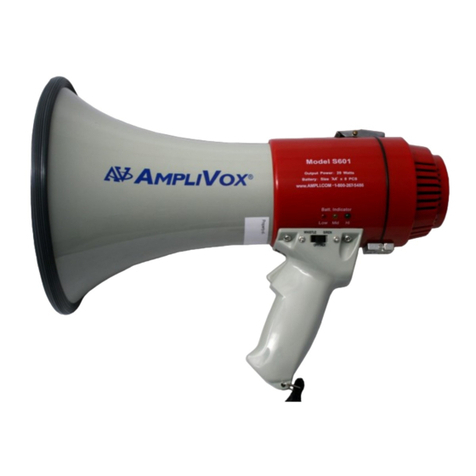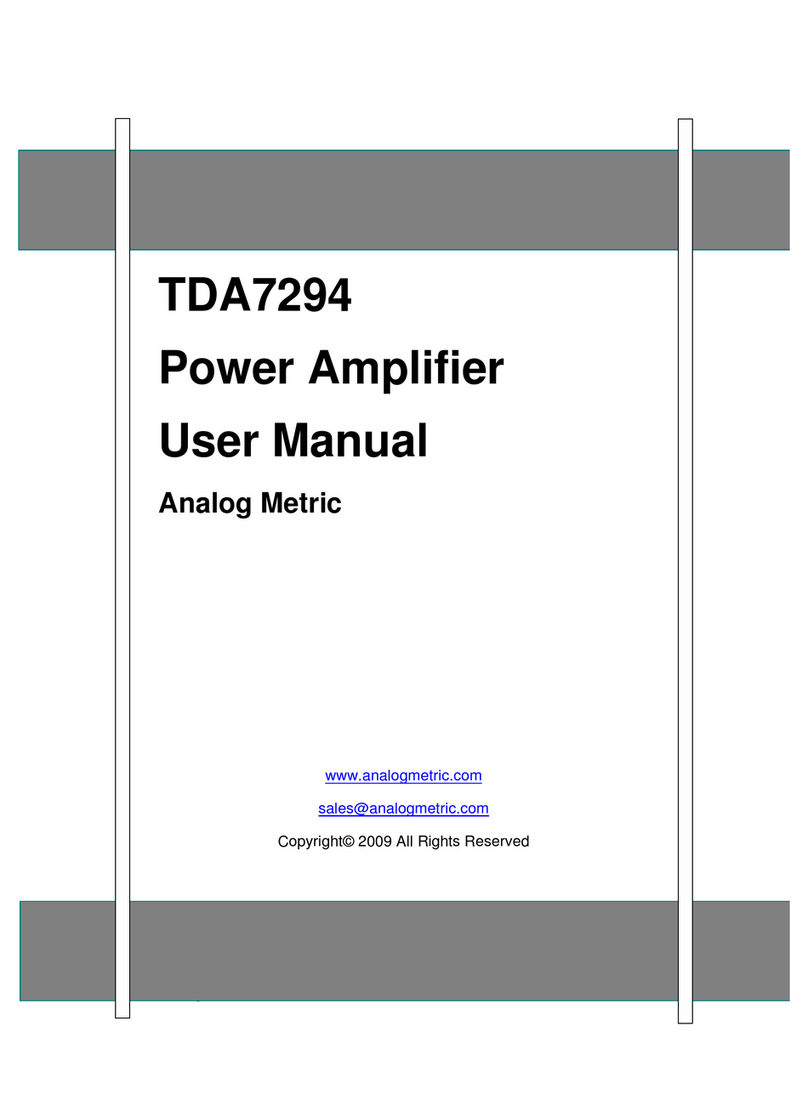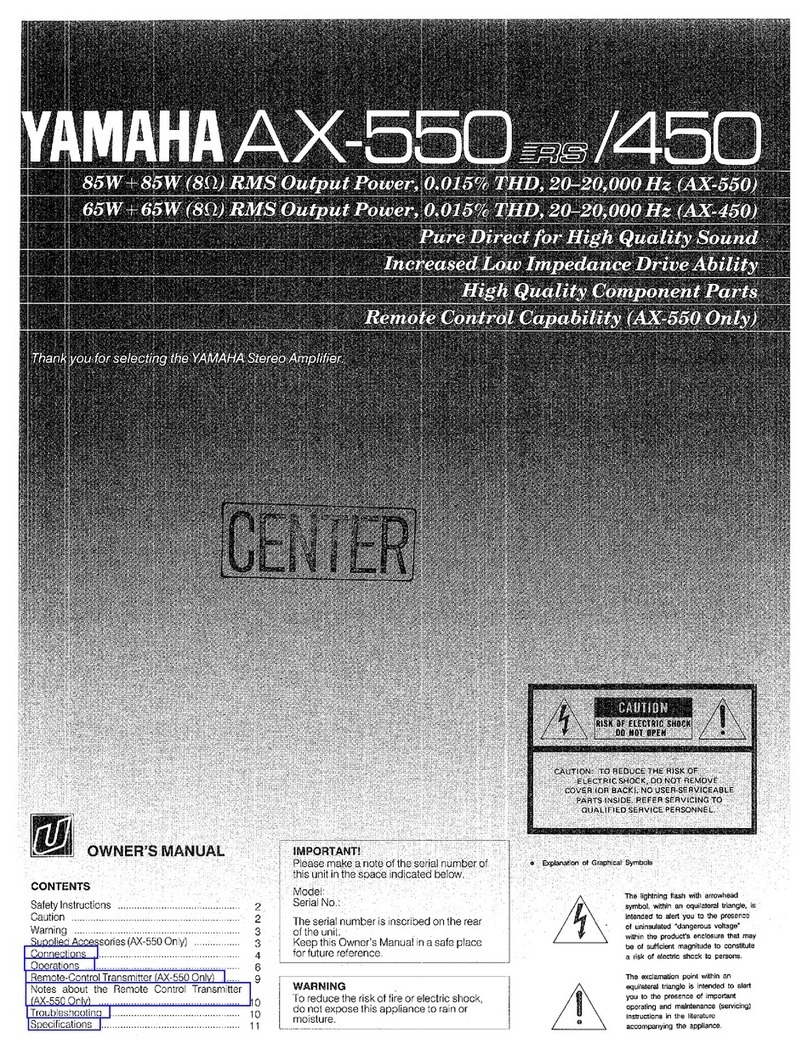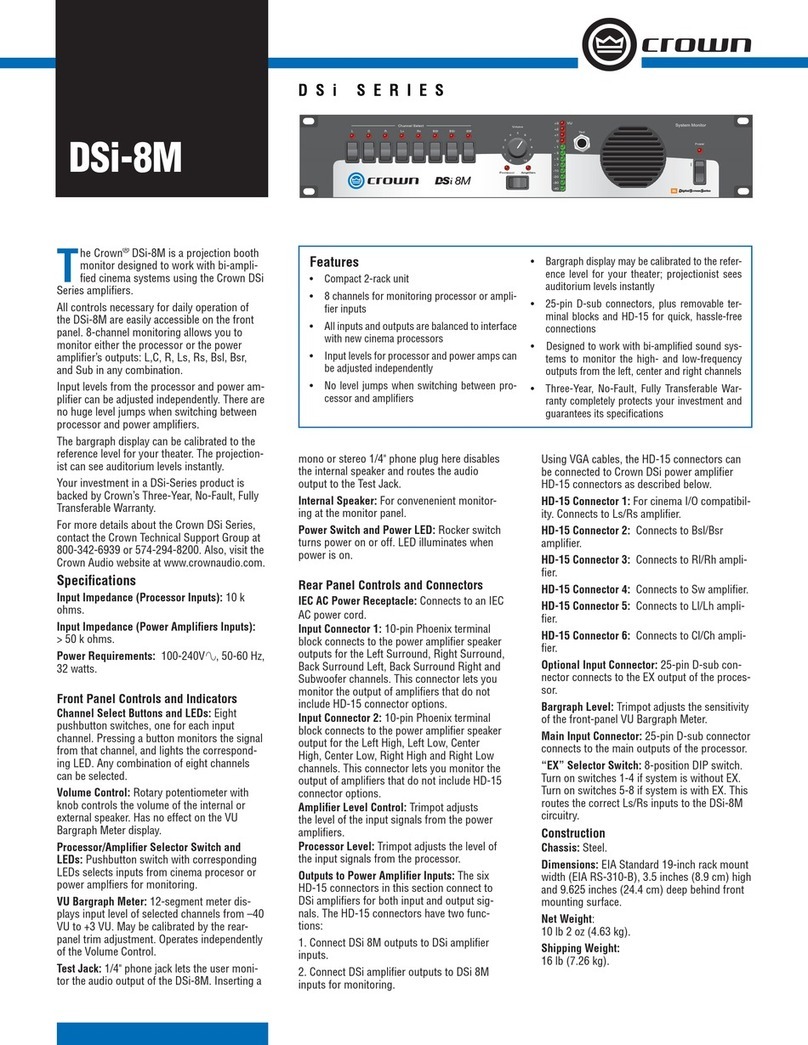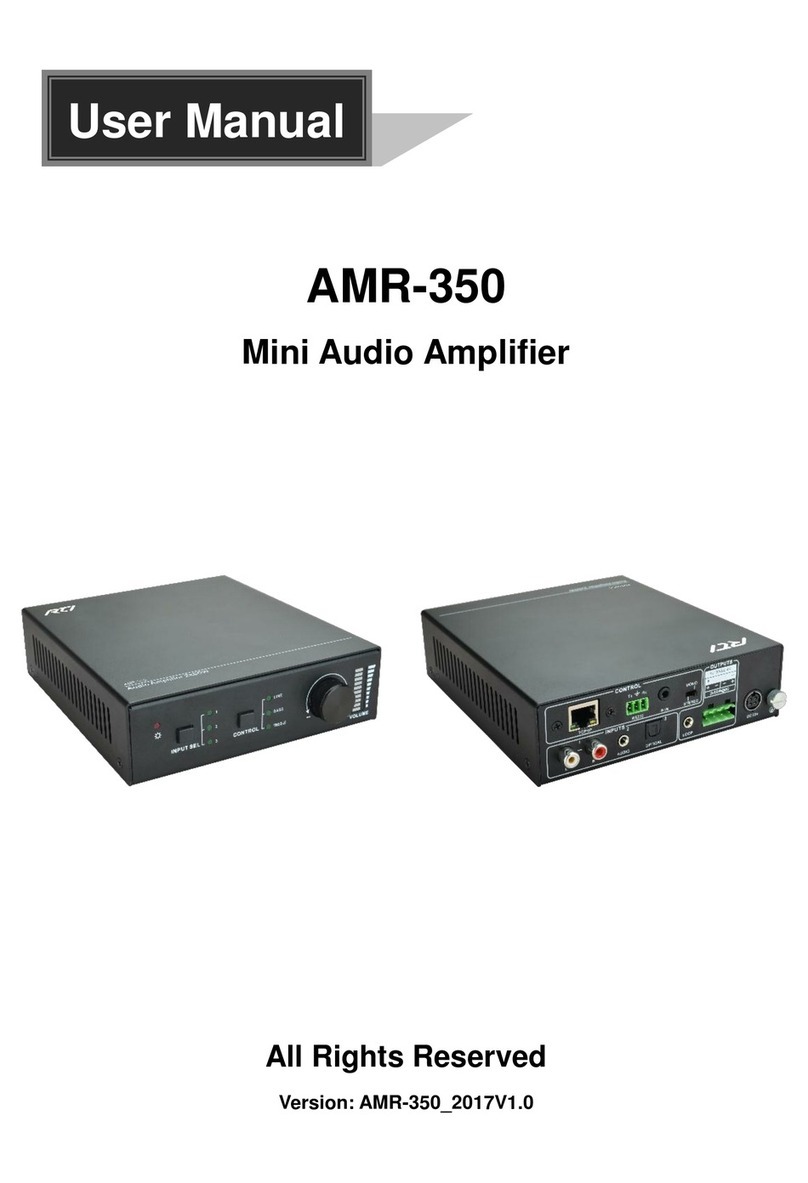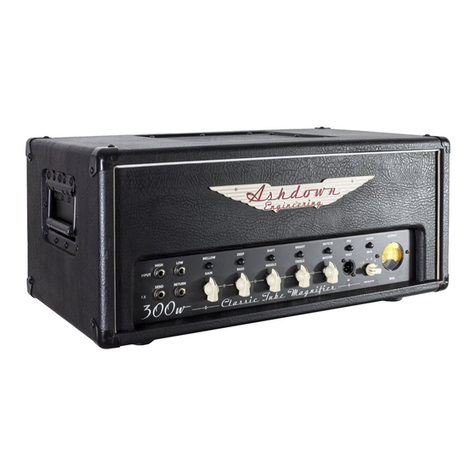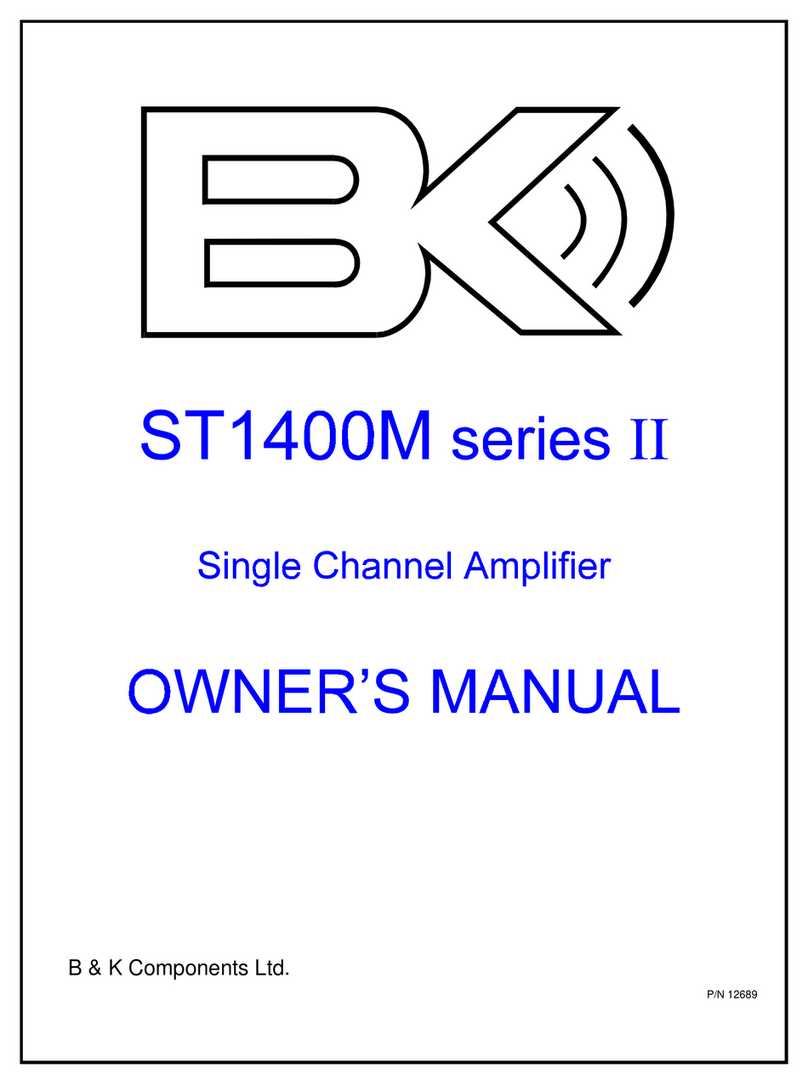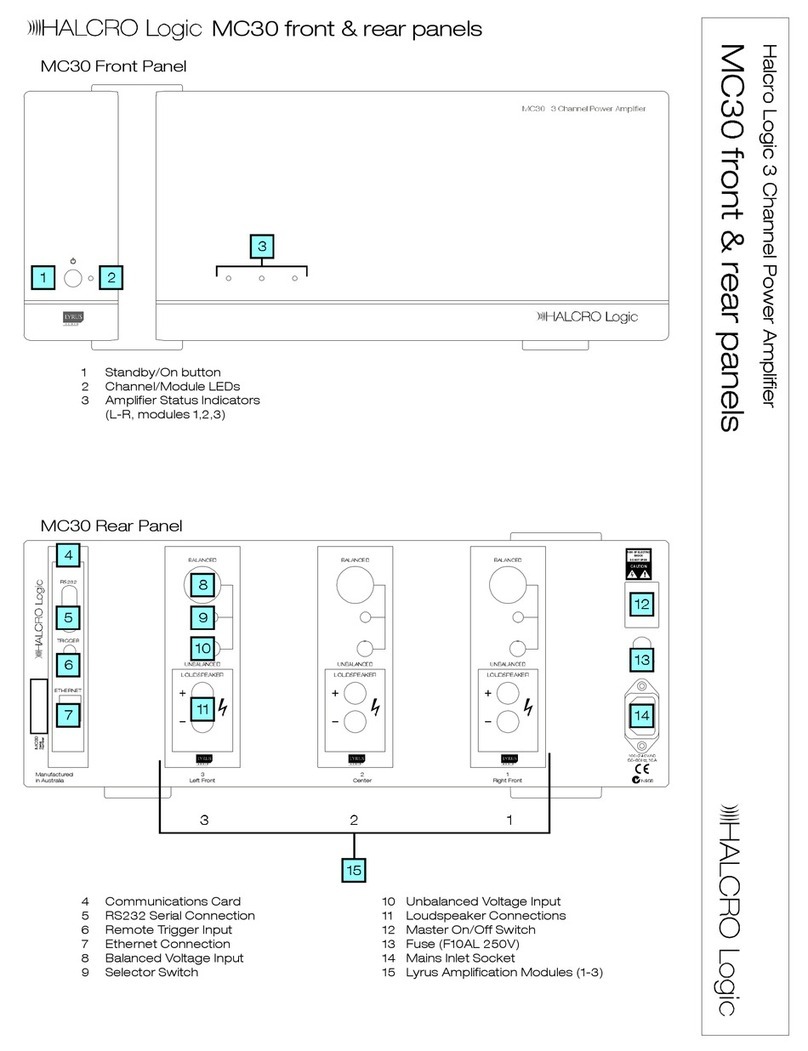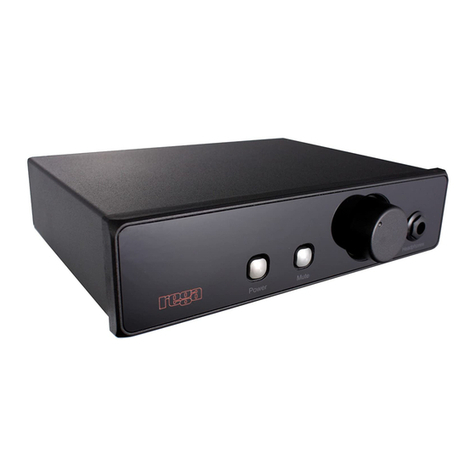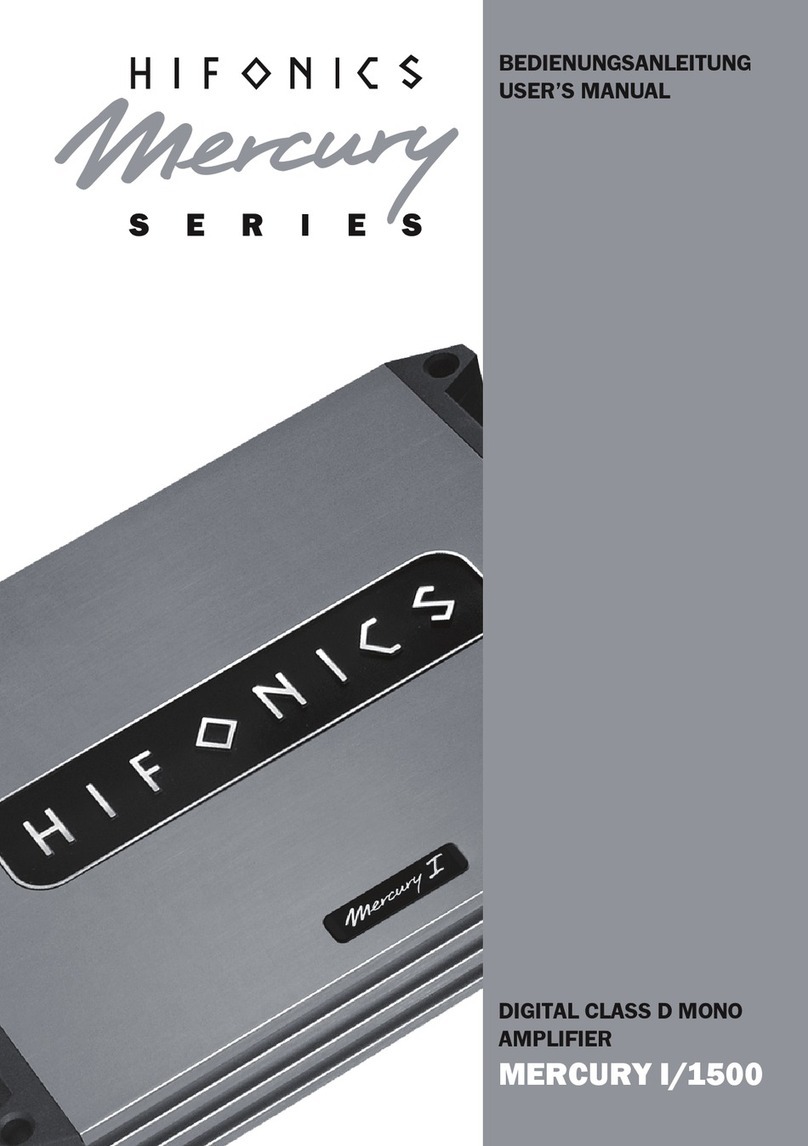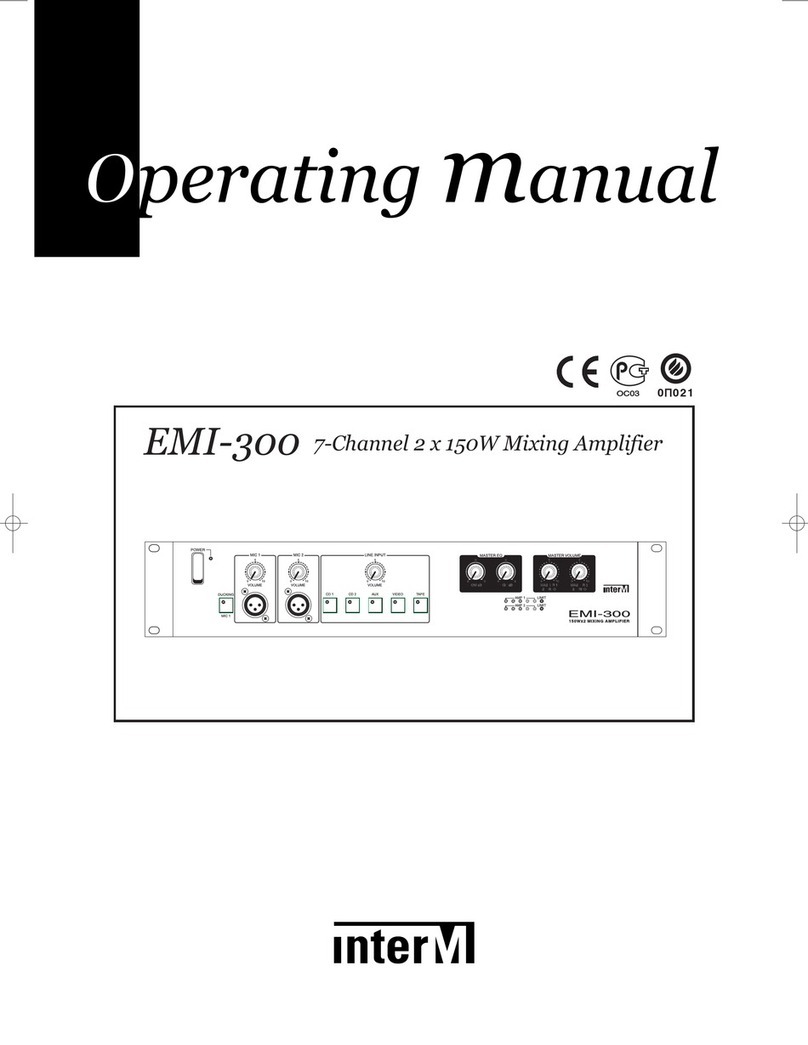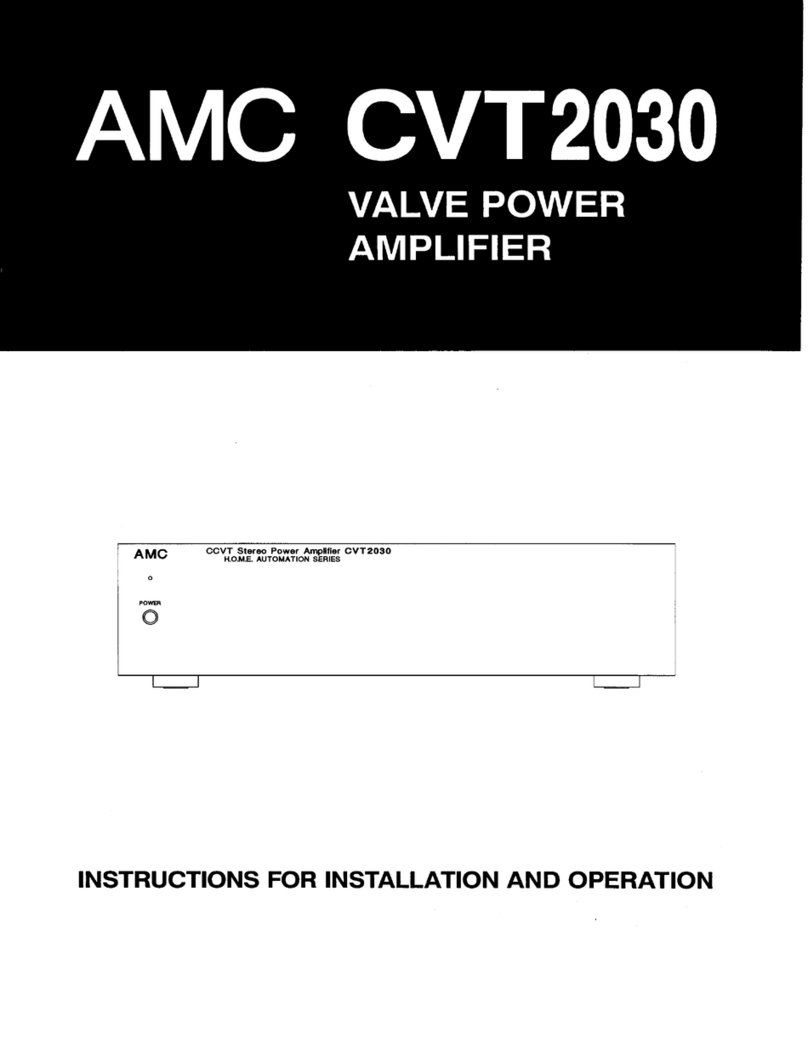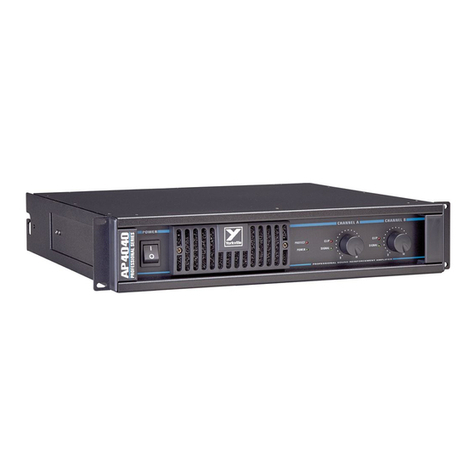Emotiva MPS-1 User manual

USER’S GUIDE


TABLE OF CONTENTS
Safety Precautions ...................................................6
NEC (National Electrical Code) Standards..............................8
A Note for the Cable Television (CATV) Installer ................................................... 8
Antenna Grounding Outside the House ................................................................. 8
Thank You for your MPS-1 Purchase....................... 9
Unpacking the MPS-1.............................................. 10
Recording the Serial Number.................................................10
Emotiva MPS-1 Modular Power Amplier ............. 11
Modular Professional Power Amplier Features ................. 11
MPS-1 Front Panel Features................................... 12
Panel Dim Selector Button..................................................................................... 12
Power Button .......................................................................................................... 12
Amplier Channel Display ..................................................................................... 12
MPS-1 Finished Rear Panel Layout ....................... 13
Balanced XLR Inputs.............................................................................................. 13
Unbalanced RCA Inputs......................................................................................... 13
Speaker Output Terminals ..................................................................................... 13
Turn On Selector Switch ........................................................................................ 14
External Trigger Connection.................................................................................. 14
Fuse #1 .................................................................................................................... 14
Fuse #2 .................................................................................................................... 14
IEC Line Cord Socket ............................................................................................. 14
Installation and Connections ................................. 15
Installation of the EPM-300 Power Modules .........................15
Tools Required........................................................................................................ 15
Unpacking the EPM-300 Module ........................................................................... 15
Orienting the Module to the MPS-1 Chassis ........................................................ 16
Inserting the EPM-300 Module............................................................................... 17
Completing the EPM-300 Installation.................................................................... 17
MPS-1 Installation Accessories .............................................18
Piano Black Wood Side Panels ............................................................................. 18
Rack Mount Installation Hardware........................................................................ 18
AC Power Considerations ......................................................19
Input Connection Considerations..........................................19
Output Connection Considerations.......................................19
Automatic Operation of the Cooling Fan(s)..........................20

Connection Tips for Superior Sound.....................................20
Connection Diagrams .............................................................21
Unbalanced Connections....................................................................................... 21
Balanced Connections........................................................................................... 22
12V Trigger Connections ....................................................................................... 23
Speaker Output Connections ................................................................................ 23
Series and Parallel Speaker Connections.............................24
Series....................................................................................................................... 24
Parallel..................................................................................................................... 25
Technical Note about Multiple Speaker Connections ......................................... 25
Speaker Placement Tips ......................................... 26
Tips Before You Begin ............................................................26
The Front Speakers ................................................................................................ 27
The Center Speaker................................................................................................ 27
Side-Axis Speakers ................................................................................................ 28
The Surround Speakers ......................................................................................... 28
Surround Back Speakers....................................................................................... 29
Subwoofer Location ............................................................................................... 29
Troubleshooting Guide ........................................... 31
No Sound (from one or more speakers connected to the MPS-1) ..................... 31
The amplier shuts down often or the line fuse(s) blows often......................... 31
Poor Bass Performance From Full Range Speakers connected to the MPS-1. 31
Turn-on and turn-off thumps ................................................................................. 32
“Hum” Noises in the Speakers.............................................................................. 32
Other Probable Causes of Noise........................................................................... 33
One or more RED lights on the Front Panel are On ............................................ 33
Technical Specications......................................... 34
Limited Warranty ..................................................... 35
Service Assistance for the MPS-1......................................................................... 35
Emotiva Disclosure ................................................................................................ 36


Page 6
Page 7
Safety Precautions
Read this Owner’s Guide thoroughly before attempting to install and congure the Emotiva MPS-1
Modular Power Amplier. All the safety and operation instructions should be read before any op-
eration of the component(s) begin. After successful installation and conguration of the Emotiva
MPS-1 Modular Power Amplier, be sure to retain this manual in a safe place for any future reference
needs.
All warnings on the Emotiva MPS-1 Amplier and in these operating instructions should be followed.
Safety is a key component to a long lasting and trouble free installation. The vast majority of the
subsequent safety precautions involve simple common sense. If you are not comfortable with the
installation of audio/video entertainment equipment, it will be to your benet to seek the services
of a qualied installation professional.
• The Emotiva MPS-1 Amplier should NEVER be used near water such as a bathtub, washbowl, kitchen
sink, laundry tub, in a wet basement, or near a swimming pool, etc.
• The Emotiva MPS-1 Amplier should be situated so that its location or installation position does not
interfere with proper ventilation.
• The Emotiva MPS-1 Amplier should not be situated on a bed, sofa, rug, or similar surface that may
block any ventilation openings; or placed in a built-in installation such as a bookcase, cabinet, or closed
equipment rack that may impede the ow of air through ventilation openings. If installed in a closed
equipment rack for custom installations, be sure to add forced air ventilation so that it has adequate
air circulation.
• The Emotiva MPS-1 Amplier should be situated away from heat sources such as radiators, or any other
devices which produce heat.
• The Emotiva MPS-1 Amplier should be connected to a power supply only of the type described in this
User’s Guide and what is labeled on the MPS-1 component. Power supply cords should be routed so
that they are not in high foot trac areas or pinched by items placed upon or against them, paying
particular attention to cords at the wall plugs, convenience receptacles, and the point where they con-
nect into the MPS-1 Amplier. The power cord of the MPS-1 Amplier should be unplugged from the
outlet when unused for a long period of time.
When it’s time for cleaning the Emotiva MPS-1 Amplier, it should be cleaned only as recommended
in this Owner’s Guide. Never spray liquids directly into the component’s vent openings. Care should
be taken so that small objects do not fall into the inside of the MPS-1 Amplier.
The following situations require your Emotiva MPS-1 Amplier is serviced only by qualied service
personnel:
1. The power-supply cord or the plug has been damaged; or
2. Objects have fallen, or liquid has spilled into the component; or
3. The MPS-1 has been exposed to rain; or
4. The MPS-1 does not appear to operate normally or exhibits a marked change in performance; or
5. The MPS-1 has been dropped, or its enclosure or chassis is damaged.

Page 6
Page 7
The user should not attempt to service the MPS-1 Modular Power Amplier beyond the means
described in this Owner’s Guide. All other servicing should be referred to qualied service per-
sonnel.
To prevent electric shock, do not use this polarized plug with an extension cord, receptacle or
other outlet unless the blades can be fully inserted to prevent blade exposure.
Pour preevenir les chocs electriques ne pas utiliser cette che polarises avec un prolongateur, un prise de
courant ou une autre sortie de courant, sauf si les lames peuvent titre inserees a fond sans laisser aucune
parIIIe a decouvert.
Grounding or Polarization — Precautions should be taken so that the grounding or polarization
means of the component is not defeated.
This apparatus does not exceed the Class A/Class B (whichever is applicable) limits for radio noise
emissions from digital apparatus as set out in the radio interference regulations of the Canadian
Department of Communications.
ATTENTION — Le present appareil numerique n’emet pas de bruits radioelectriques depassant las limites
applicables aux appareils numeriques de class A/de class B (selon le cas) prescrites dans le reglement sur
le brouillage radioelectrique edicts par les ministere des communications du Canada.
For questions regarding service, please contact:
Emotiva
106 Mission Court, Suite 101
Franklin, TN 37067
Tel - (615) 771-1224 (877) EMO-TECH
Fax - (615) 771-1128 www.emotiva.com
If you purchased your MPS-1 from AV123, please contact them directly for service or technical ques-
tions. They can be reached at (877) 543-7500 or suppor[email protected].
WARNING – TO REDUCE THE RISK OF FIRE OR ELECTRIC SHOCK, DO
NOT EXPOSE THIS APPLIANCE TO RAIN OR MOISTURE.
CAUTION: TO PREVENT ELECTRIC SHOCK, MATCH WIDE BLADE OF PLUG
TO WIDE SLOT, FULLY INSERT.
ATTENTION: POUR EVITER LES CHOCS ELECTRIQUES, INTRODUIRE LA
LAME LA PLUS LARGE DE LA FICHE DANS LA BORNE CORRESPONDANTE
DE LA PRISE ET POUSSER JUSQU’AU FOND.

Page 8
Page 9
NEC (National Electrical Code) Standards
A Note for the Cable Television (CATV) Installer
This reminder is to call the CATV system installer’s attention to Article 820-40 of the NEC that provides
guidelines for proper grounding and in particular, species that the cable ground shall be connected
to the grounding system of the building as close to the point of cable entry as practical.
Antenna Grounding Outside the House
If an outside antenna is connected to the receiver, be sure the antenna system is grounded so as to
provide some protection against voltage surges and built-up static charges. Article 810 of the Na-
tional Electrical Code, ANSI/NFPA 70, provides information with regard to proper grounding of the
lead-in wire to an antenna-discharge unit, connection to grounding electrodes, and requirements
for the grounding electrode. See diagram below.
Cable TV Coaxial Cable, Satellite
Dish Cables, and Television
Antennas should be grounded
BEFORE the point of entry into
the house.

Page 8
Page 9
Thank You for your MPS-1 Purchase
Dear Home Entertainment Enthusiast,
Thank you for purchasing the Emotiva MPS-1 Modular
Power Amplier. We sincerely believe that it oers
you outstanding performance and value. Emotiva
products are engineered and produced with the
highest quality materials and incorporate the latest
technology. We think you will nd the Emotiva MPS-1
meets or exceeds your expectations.
The Emotiva MPS-1 is a exible, high perfornmance amplifer. It has been designed for maxmum
performance, ease of use, and installation exibility. By employing cutting edge technology, the
Emotiva MPS-1 easily power to your speakers at high power levels, at the same time remaining
as ecient as possible, regardless of volume levels. This allows you to fully enjoy audio and video
sources without concern for dynamic headroom during complex musical passages and high level
eects. What’s more, the Emotiva MPS-1 does it all with exceptionally rened cosmetics and a sound
quality that will satisfy even the most discriminating tastes.
The Emotiva MPS-1 features an array of leading edge technologies and all the features necessary to
perform the functions expected of a high end Modular Power Amplier.
The Emotiva MPS-1 Modular Power Amplier is a rock solid component that allows you to control
and manage all of your system’s speakers with 7 individual ampliifers in a single, easy-to-use amplier
chassis. This makes installation of your home entertainment system much easier than connecting
multiple mono or two channel ampliers. At Emotiva, we remember that creating home audio/video
products means that they should be easy to use while delivering unparalleled performance.

Page 10
Page 11
Unpacking the MPS-1
The Emotiva MPS-1 Modular Power Amplier should reach you in awless condition. If you notice
any shipping damage or other issues upon unpacking the unit, please contact your Emotiva Retailer
immediately.
Gently lift out the unit and remove all the packing material and accessories. It is important to save all
the packing materials and the box in case your Emotiva MPS-1 ever needs to be moved or shipped
back to the factory for service.
Make sure that you keep your sales receipt. It is the only way for Emotiva to establish the duration
of your Limited Warranty and it may come in useful for insurance purposes. Please take a moment
to ll out and mail the Emotiva Customer Response card.
Recording the Serial Number
Please read the serial number located on the rear panel and record it below. Also record the place
where you purchased this product and the date of purchase.
Model Number MPS-1
Place of Purchase
Serial Number
Date of Purchase

Page 10
Page 11
Emotiva MPS-1 Modular Power Amplier
Modular Professional Power Amplifier Features
• Audiophile quality, modular power amplier
• True card cage design can accommodate up to seven independent 200 watt mono block power modules
- power modules glide in and out on Nylon rails
• Power modules feature independent 350VA, low noise toroid power transformers w/ high speed rectiers
and 48,000uF of storage per channel for a 336,000uF total, across seven independent channels
• High eciency Class H power amplier design, minimizes power losses and allows cool and ecient
operation
• Complementary, discrete power amplier design incorporating high current, high speed, Toshiba power
devices
• 200 Watts x 7 into 8 Ohms (using seven EPM-300 Power Modules)
• 300 Watts x 7 into 4 Ohms (using seven EPM-300 Power Modules)
• 400 Watts x 7 into 2 Ohms (using seven EPM-300 Power Modules)
• Power modules are completely stable into 2 ohm loads
• Truly transparent, integrated soft clip circuitry
• Balanced XLR and RCA inputs
• Silent turn on/o - No audible transients
• THD less than .015%, 20Hz-20kHz with 80kHz measurement bandwidth
• DC oset, less than 1mv, servo controlled.
• Crosstalk between ANY channels – greater than 120dB
• All aluminum capacitors are premium quality, low ESR, 105°C rated for high reliability and perfor-
mance
• Doubled sided, plate through, glass epoxy, FR4 PCB’s used throughout with 2 ounce poured copper on
all power sections and ground planes
• Individual channel status indicators for standby, operate, and fault behind tinted acrylic panel
• Fully protected from all fault conditions with ultra quiet, module mounted, fan assisted cooling for
severe duty cycle applications
• Soft start circuitry
• Signal sensing auto turn-on or remote 12 VDC trigger. Soft touch power switch
• Modules are designed for eld replacement with the removal of four screws
• Black lacquered, piano nished wood side panels are included, as are milled aluminum rack ears for
professional installations
• Massive, multi element milled aluminum faceplate with “oating” wing detail – indirect, cobalt blue
panel illumination with panel dimmer
• IEC power inlet, 120/230 VAC user congurable

Page 12
Page 13
Power Button
This turns the main power to the MPS-1
on or o. It is a main power button, but it
is not required to turn this on and o each
time the MPS-1 is used. When enabled, the
AUTO ON/OFF MODE will automatically
switch the amplier on when an audio
signal comes from a source or control
unit (such as a preamplier). The TRIGGER
MODE will turn the amplier on when an
external source (such as a preamplier)
provides a 5-24 VDC input on the trigger
terminals.
Panel Dim Selector Button
This button selects the overall brightness
of the lighting on the front panel of the
MPS-1. The button has four steps, each
consecutively after the other. The four
levels of brightness are:
• High
• Medium
• Low
• OFF
Pressing the PANEL DIM button repeatedly
will scroll through each level of bright-
ness.
MPS-1 Front Panel Features
Amplier Channel Display
This multi-color LED display behind a tinted
acrylic panel shows activity of any of the
seven power modules on the MPS-1 doing
amplication duties.
BLUE LIGHT: Power Module is installed, on
and ready.
AMBER LIGHT (middle row): Power mod-
ule is installed and powered on but is in a
standby situation waiting for audio signal
or exernal trigger.
RED LIGHT: This indicates a fault condition.
A fault condition is one or more of the foll-
wing:
• Excessive Operating Temp
• Excessive Current (Short Circuit)
• DC on the Outputs
See the “Troubleshooting Section” for more
details on the display.
Note - When there is NO LIGHT - The power
module is not installed, the power module’s
fuse is blown, or connection between the
power module and the chassis is mis-
aligned.
12
3
1
2
3

Page 12
Page 13
Unbalanced RCA Inputs
The MPS-1 has one unbalanced RCA input
available for each amplier channel mod-
ule. Connect this to the corresponding RCA
jack on your preamplier to provide signal
to the amplier channel. See page 21 for a
connection diagram.
Speaker Output Terminals
The speaker output terminals for each am-
plier channel are located just below the
balanced XLR input jack. The top post of
each binding post pair is the positive out-
put, and connects to the positive (red) post
of your speaker. The bottom post of each
pair is the negative, and connects to the
negative (black) post of your speaker. The
posts can accept bare wire, spade terminals,
and dual or single banana connectors.
Spade connections or banana plugs ensure
a simple, solid t in the terminal whereas
bare wire may be awkward when the ter-
minal is screwed down to compress the
wire into place. Keep in mind that if you
use “dual banana” plugs and “stack” them,
you will be creating a parallel connection.
For more details on series and parallel con-
nections, see pages 24-25.
MPS-1 Finished Rear Panel Layout
Balanced XLR Inputs
The MPS-1 has one balanced XLR input
available for each amplier channel mod-
ule. Connect this to the corresponding
XLR jack on your preamplier to provide
signal to the amplier channel. If you have
a choice, use the balanced XLR connections
whenever possible. Balanced connections
oer superior noise immunity over unbal-
anced RCA connections.
On the balanced XLR connector, the wiring
is as follows:
Pin #1 = Ground
Pin #2 = Signal +
Pin #3 = Signal -
See page 22 for a connection diagram.
Pin #1 Pin #2
Pin #3
Note: Before connecting any components to the MPS-1, the individual power modules must rst be
installed into the chassis. Please see pages 15-17 for details on the power module installation.
5
6
7
1
2
3
4
8
1
2
3

Page 14
Page 15
Turn On Selector Switch
This switch allows you to select how the
amplier will turn on and o.
In the ON (Up) position, the switch on the
front of the amplier is the method you
will use to power up and power down the
amplier. Please note that in this congu-
ration, you must manually power up and
power down the amplier each time you
use it or it will have unnecessary standby
current draw.
In the SIGNAL (Middle) position, the am-
plier automatically turns on whenever it
senses an audio signal on any one of the
seven amplier channels. The circuit stays
active for a full minute after the absence of
any audio signal to account for quiet pas-
sages of music or dialogue.
In the TRIGGER (Down) position, the ampli-
er’s ON and OFF functions are controlled
by a trigger from a source or preamplier
device. The trigger accepts 12 VDC and will
turn the amplier on whenever a trigger is
present (See #5). When there is no trigger,
the amplier goes into standby mode. This
is the preferred method for activating the
MPS-1.
External Trigger Connection
This external trigger connection allows
the amplier to be turned ON and OFF by
a control device such as a source unit or
preamplier. It can also be used with most
home automation controllers. The trigger
requires a 12 VDC trigger. This is the pre-
ferred method of activating the MPS-1. See
page 23 for connection details.
Fuse #1
This fuse is for the power supply of the MPS-
1 chassis. It is a TL15AL type rated a 15A, 250
V. If the fuse ever fails, be sure to replace it
with the same type and rated fuse.
Fuse #2
This fuse is also for the power supply of
the MPS-1 chassis. It is a TL15AL type rated
a 15A, 250 V. If the fuse ever fails, be sure
to replace it with the same type and rated
fuse.
IEC Line Cord Socket
The MPS-1 comes with a detachable line
cord which connects here. Plug the line
cord into an AC wall socket which is cor-
rectly configured with the voltage and
current supply specied for the MPS-1. Do
not plug this line cord into a power strip,
it must plug directly into a wall socket. For
more details on AC power considerations,
see page 19.
Turn On Selector Switch
External Trigger
Connection
5
6
7
4
8

Page 14
Page 15
Installation and Connections
Observe the following precautions when choosing a location for your Emotiva MPS-1:
1) Protect it from prolonged exposure to direct sunlight and other direct sources of heat, such as heating
vents and radiators.
2) Do not expose the unit to rain or moisture. If uid or a foreign object should enter the unit, immediately
turn o the power and contact your Emotiva Dealer.
3) Avoid excessive exposure to extreme cold or dust.
4) Do not place heavy objects on top of the unit.
5) If you need to clean the front surface, rst turn o the power and then use a soft dry cloth, rubbing with
the grain. Be careful not to scratch the display window.
Installation of the EPM-300 Power Modules
The MPS-1 is shipped without the EPM-300 power modules installed so that the packaging is not
subject to unnecessary shipping damage. The modules must be installed prior to use, however this
is a straight forward task and is very simple.
Tools Required
You will need a #2 Phillips screwdriver to complete this task. Once the
installation of the modules are complete, you may also need wire cutters
and strippers to prepare the trigger plug and speaker wires for connection
to the MPS-1.
Unpacking the EPM-300 Module
You should have received your MPS-1 in a total of three boxes. The main MPS-1 chassis is in one of
the boxes. The other boxes contain the EPM-300 power modules, one box with ve modules and
the other box with two modules. All of the installation accessories are packaged with the MPS-1
chassis.
Unpack each EPM-300 module one at a time, install the module per instructions, then proceed with
the next one. Avoid touching any of the circuitry or the cooling fan as you handle the EPM-300
module.

Page 16
Page 17
Orienting the Module to the MPS-1 Chassis
Upon removing the EPM-300 power module from the packaging, you must orient which is the “top”
and “bottom” as well as which is the “front” and “back”. The top has a single nylon rail while the bot-
tom has two nylon rails. It is important that the module be placed in so that the rails on the top and
bottom align with the corresponding “rail channels” in the MPS-1 chassis. The front of the module
that will be inserted into the chassis has an AC receptacle and a small printed circuit board while
the back of the module is where you will nd the RCA/XLR connectors and speaker outputs.
Before inserting the power module, conrm that the 115/230 VAC voltage setting is correct for the
country in which you are installing the MPS-1. These should be set correctly (by default) at the fac-
tory at the time of testing and packaging.
Front Back
Single
Rail
(Top)
Dual
Rails
(Bottom)
EPM-300 Power Module orientation
The back of the MPS-1 chassis looking “in” where the
EPM-300 module will be installed. (For clarity, the EPM-
300 modules are shown installed on either side of the
empty opening)
EPM-300 Power
Module bay Single
Rail
(Top)
Dual Rails
(Bottom)
Front Back

Page 16
Page 17
Inserting the EPM-300 Module
CAUTION: Make sure the MPS-1 chassis is NOT CONNECTED to line voltage during the installation
of the power modules!
For proper installation of the power module, the
nylon rail guides must be aligned with the metal rails
channels inside the MPS-1. There is very little tolerance in
the design for misalignment, so installation should be somewhat
easy if you have the module congured correctly. Begin to insert the
power module into the MPS-1 chassis. Insertion of the power module is smooth and easy and it will
not require any excessive force. If you must force the power module in, stop and re-evaluate your
alignment of the nylon guide rails. Excessively forcing the power module can damage it. Use care
not to damage the fan or electronic components during this installation. The power module is fully
inserted when it bottoms out in the back of the MPS-1 chassis.
Completing the EPM-300 Installation
Once the power module is inserted, you must attach it to the MPS-1 chassis with four #2 phillips
screws (provided). The screw holes on the back panel should line up to threaded holes in the MPS-
1 chassis. Install and tighten the screws, then proceed with the installation of subsequent power
modules.
Once the installation of all power modules is completed, use the supplied CHANNEL I.D. decals to
identify each power module for easy channel identication.
Front
Back
Single Nylon Rail
(Top)
Gently align the rails and slide the
Power Module into place
MPS-1 Chassis
Once installed, attach (4) #2
Phillips screws to secure the
Power Module
2
1
2
1

Page 18
Page 19
MPS-1 Installation Accessories
The MPS-1 Modular Power Amplier comes with some additional installation accessories that make
the component t into virtually any installation theme.
Piano Black Wood Side Panels
The MPS-1 comes with attractive wood side panels in a stunning piano black lacquer nish. As this
electronic component is going to be in many homes alongside equally nice furniture, the side panels
allow the MPS-1 to look a little more like it belongs in the room. Although every installation will not
require them, they are included for the owner to use if he/she so chooses.
To clean the piano black nish, simply use a damp cloth (dampened with water) and wipe them down.
Then use a soft dry cloth to dry and bu the nish to its original shine. Do not use any chemicals on
the side panels. Chemical cleaners may cloud the nish of the laquer.
Rack Mount Installation Hardware
In the event the user chooses to mount the MPS-1 in a “rack mount” conguration, the unit has rack
mount ears included. To install the MPS-1 into a rack mounting conguration, the following details
must be completed.
1) The piano black wood side panels must be removed, This is accomplished by simply removing
the four #2 Phillips screws on each panel.
2) The four aluminum feet of the MPS-1 chassis must also be removed. This is accomplished by re-
moving one #2 Phillips screw directly in the center of the foot
3) Remove two #2 Phillips screws attached at the front edge of the side panel.
4) Attach the rack mount ears to the side panels using the longer #2 Phillips screws provided.
5) When installing into a rack mounting position, be sure to provide adequate support from the
sides and/or rear of the unit to avoid any unnecessary stress on the chassis.
6) Be sure the MPS-1 has adequate ventilation. At least 1 empty rack space above AND below the chassis
will allow fresh air to circulate around the unit.

Page 18
Page 19
AC Power Considerations
Ensure that the unit is plugged into an outlet capable of supplying the correct voltage and current
specied for your model. Remember to account for the electrical power that other components will
require if they share a common wall socket or electrical circuit. The majority of household electrical
sockets in places other than the kitchen and garage are 15 amperes maximum. Most DVD players
and other source components are fairly low current items. When all seven of the power modules
are installed, the Emotiva MPS-1 requires a minimum of 15 amperes @ 120 volts or 8 amperes @ 230
volts. It should be sucient to allow the other devices such as preampliers and A/V source units
to share a wall socket, but power ampliers such as the MPS-1 and a video display (big screen TV or
video projector) should be provided a SEPARATE electrical connection on a SEPARATE circuit. As the
MPS-1 has a minimum requirement that consumes one entire circuit, please use a second (separate)
electrical connection for other devices. DO NOT plug the MPS-1 into a power strip or extension cord
unless the device is specically designed and rated for high current use.
Refer to your preamplier, A/V source component(s), and video display owner’s manuals to learn
the power requirements so you can safely plan your electrical power requirements for your home
entertainment system.
Input Connection Considerations
The MPS-1 contains both unbalanced RCA inputs and balanced XLR inputs. You must choose one or
the other for each channel connected. You cannot use XLR cables in, with RCA out, or RCA in with
XLR out. There is no direct internal connection between the RCA and XLR inputs.
Whenever possible, keep preamp level audio cables away from electrical power cords by at least a
few inches. It’s more important with ampliers as the AC power cords are carrying much more cur-
rent than other source and preamplier components, which means there is a larger degree of noise
or “hum” potential with the amplier power cord proximity.
Output Connection Considerations
The output connectors provided on each channel of the MPS-1 are standard “binding post” speaker
connectors with industry standard spacing. These are sometimes called 5-way binding posts because
of the many ways in which the speaker wire can connect into the posts. The posts can accept bare
wire, spade terminals, and dual or single banana connectors. Spade connections or banana plugs
ensure a simple, solid t in the terminal whereas bare wire may be awkward when the terminal is
screwed down to compress the wire into place. Keep in mind that if you use “dual banana” plugs
and “stack” them, you will be creating a parallel connection. For more details on series and parallel
connections, see pages 24-25.

Page 20
Page 21
It is important to observe polarity so that the speaker wire connects to the red and black terminals
on the amplifer and the corresponding terminals at the speaker. Also make sure that the positive
speaker wires do not touch the negative speaker wires, or any chassis metal. This will cause a short
circuit and activate the protection circuitry.
Automatic Operation of the Cooling Fan(s)
Each power module in the MPS-1 is equipped with a cooling fan to maintain a safe operating tem-
perature. During normal operation the fan is o. The fan only becomes operational when it is required
to cool the power module at temperatures in excess of 50 degrees Celsius (122 degrees Fahrenheit).
The speed of the fan will increase as the temperature increases. The fan will turn o when the power
module cools to 30 degrees Celsius (86 degrees Fahrenheit).
Connection Tips for Superior Sound
Before setting up your new system, please consider the following:
• Always make sure the MPS-1 is turned o before making or changing ANY connections.
• Whenever possible, route the power cords away from the signal cables or speaker wires to prevent
any hum or interference heard in the speakers.
• Many RCA type patch cords can be a very tight t and there is usually a preferred method of get-
ting them o. Some have to be removed with a twisting action. Be gentle or you may damage the
jacks of your MPS-1, the cables themselves, or other components.
• Many audiophile signal cables are intended to be hooked up in one direction. If this is the case the
cables will be marked with arrows the direction of signal ow.
• It is usual for the right channel RCA patch cord plugs to be red and the left channel connections
to be white, grey, or black (depending on the cable brand). RCA connectors that are gold will be
designated with a colored band to designate the channel.
• If the preamplier to which you will connect the MPS-1 features balanced XLR outputs, use the
MPS-1’s balanced XLR inputs instead of RCA type patch cords. Balanced signal transmission be-
tween audio components provides superior rejection of hum and noise, especially if long cables
are required.
Table of contents
Other Emotiva Amplifier manuals
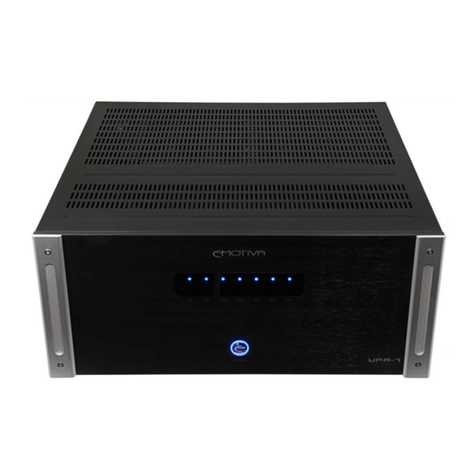
Emotiva
Emotiva Ultra UPA-7 User manual

Emotiva
Emotiva BasX A-400Z User manual
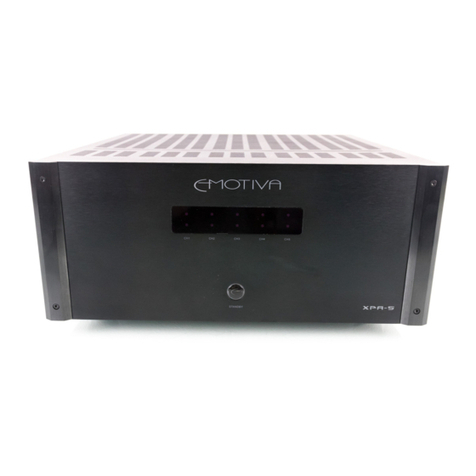
Emotiva
Emotiva Gen 2 XPA-5 User manual

Emotiva
Emotiva XPA-1 GEN 2 User manual

Emotiva
Emotiva LMC-1 User manual
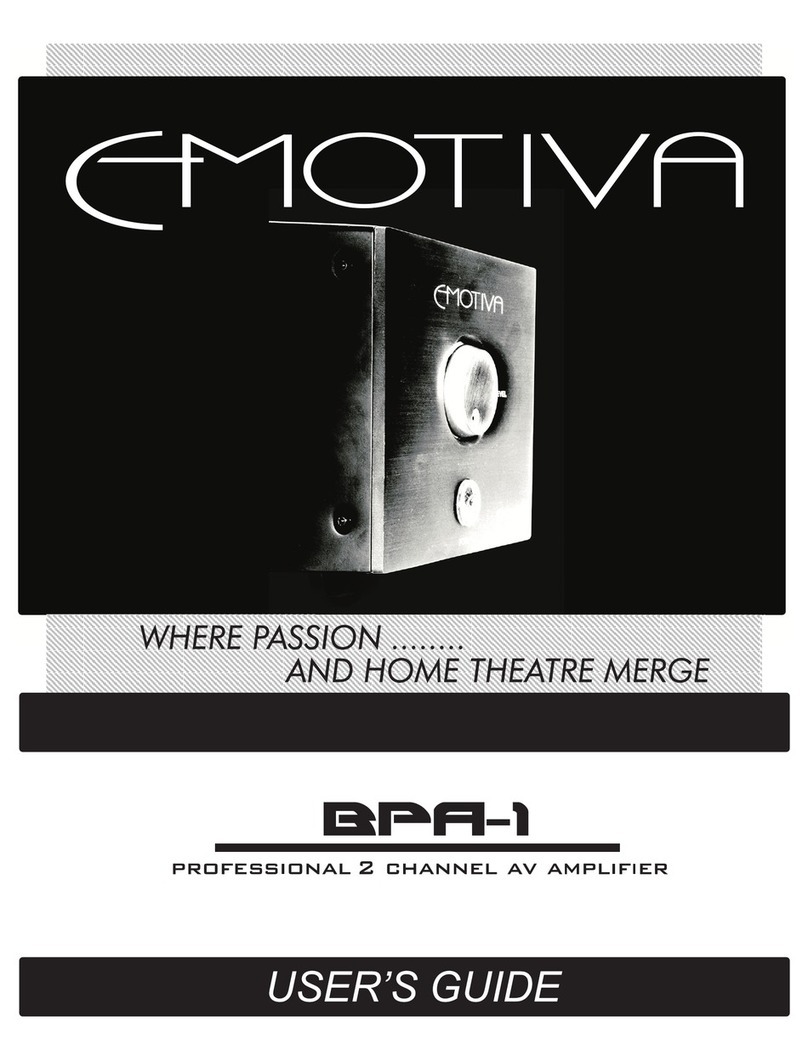
Emotiva
Emotiva pmn User manual
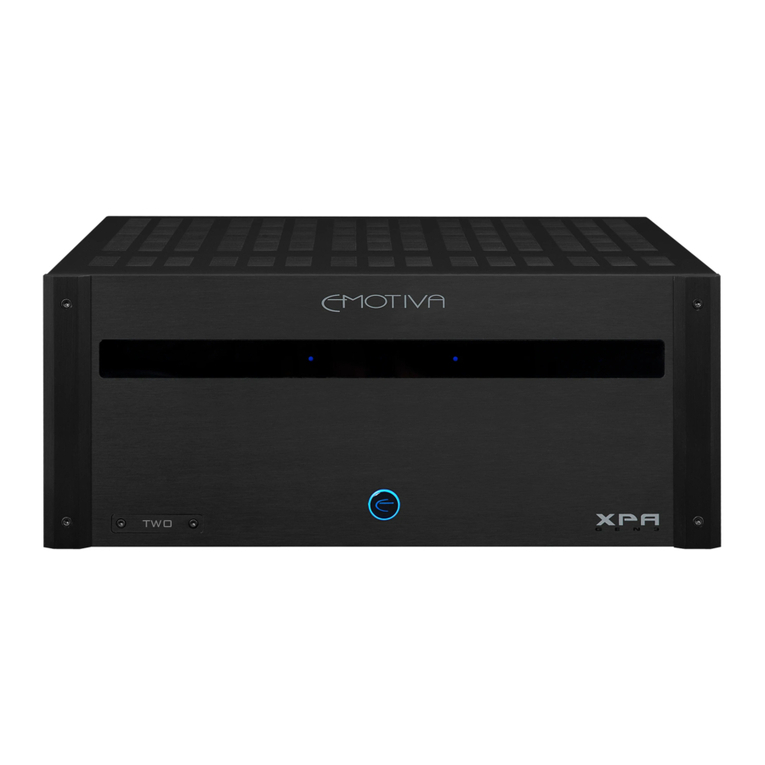
Emotiva
Emotiva Gen 2 XPA-3 User manual

Emotiva
Emotiva UPA-500 User manual
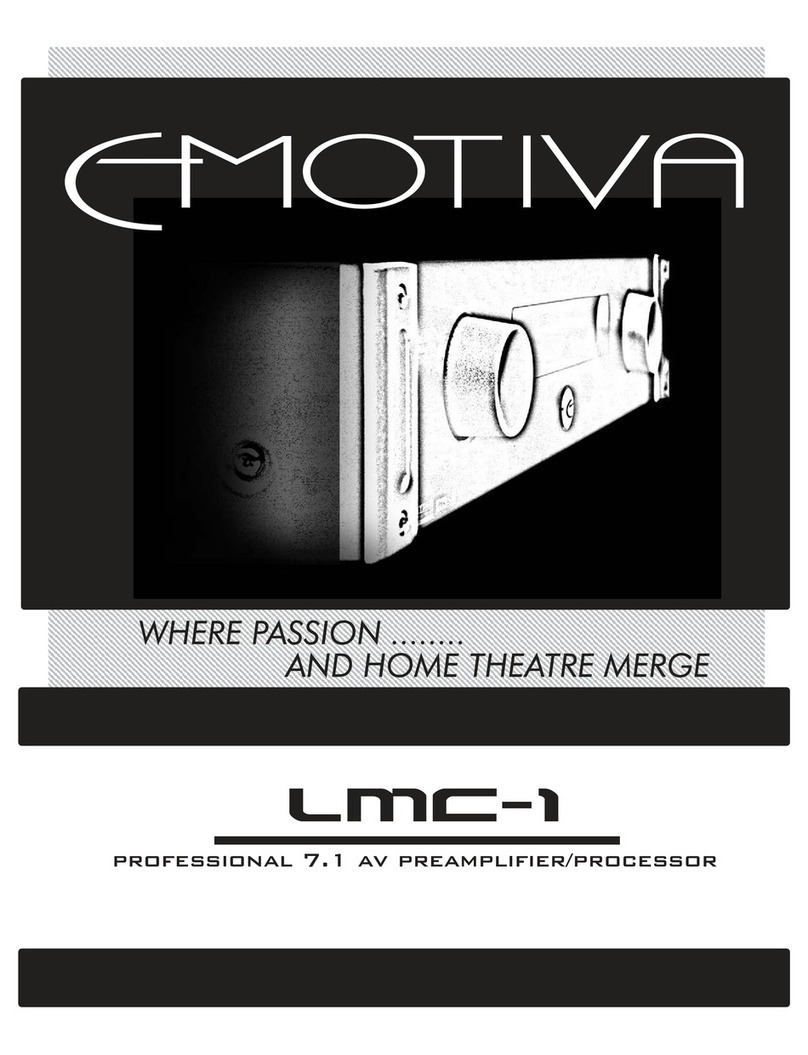
Emotiva
Emotiva LMC-1 User manual
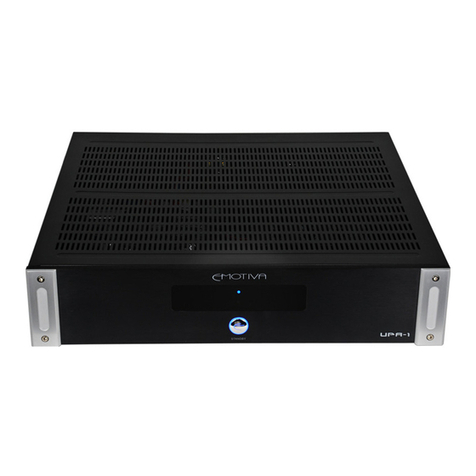
Emotiva
Emotiva Ultra UPA-1 User manual
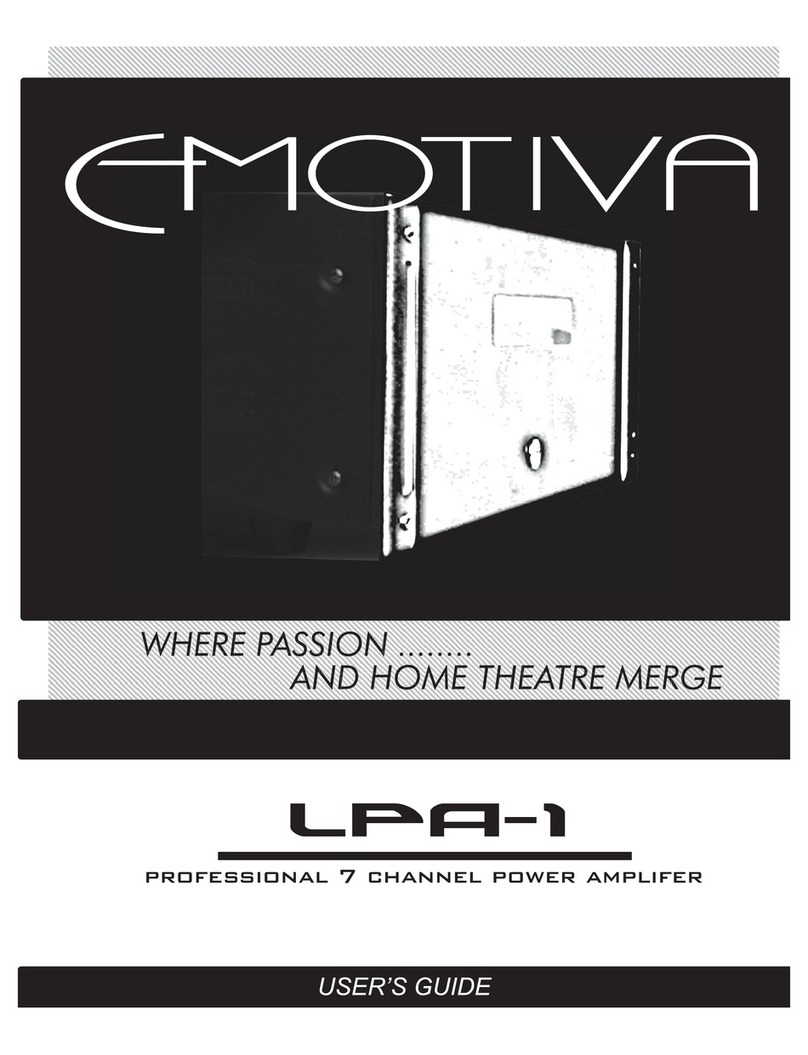
Emotiva
Emotiva LPA-1 User manual

Emotiva
Emotiva RSP-1 User manual
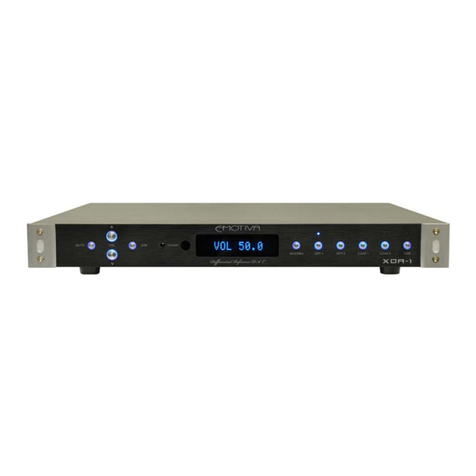
Emotiva
Emotiva XDA-1 User manual
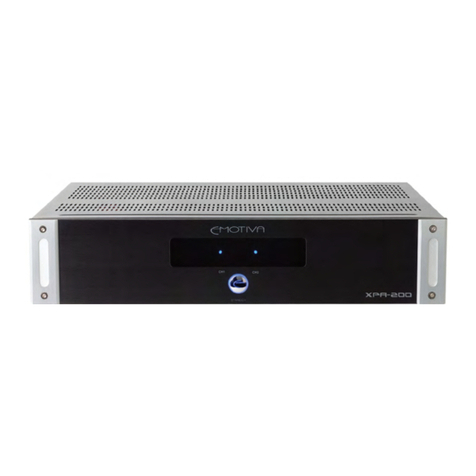
Emotiva
Emotiva XPA-200 User manual

Emotiva
Emotiva UPA-700 User manual
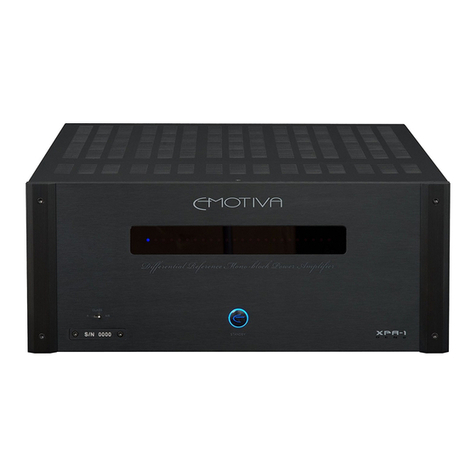
Emotiva
Emotiva XPA-1 User manual
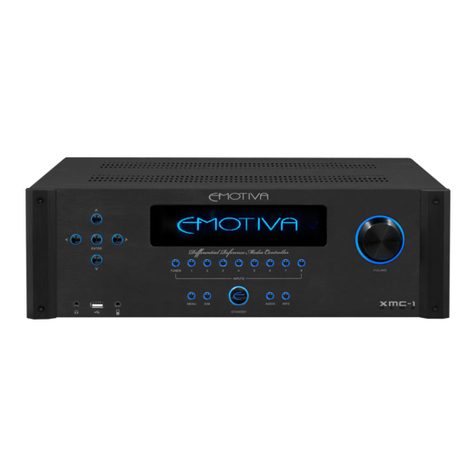
Emotiva
Emotiva XMC-1 User manual

Emotiva
Emotiva BasX PT1 User manual

Emotiva
Emotiva Stealth PA-1 User manual

Emotiva
Emotiva BasX A-800 User manual

